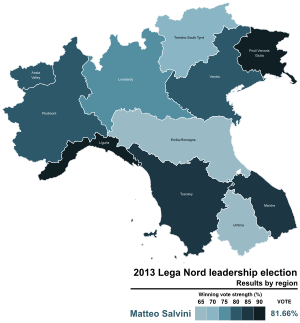2013 Lega Nord leadership election
The 2013 Lega Nord leadership election took place in November–December 2013.
| |||||||||||||||||
| |||||||||||||||||
 | |||||||||||||||||
| |||||||||||||||||
Background and race
In September 2013 Roberto Maroni, who had been secretary of the party for just about a year, announced he would soon step down from the party's leadership.[1][2]
A federal congress was scheduled for mid December and five candidates filed their bid to become secretary: Umberto Bossi (the party's founder and former leader), Matteo Salvini, Giacomo Stucchi, Manes Bernardini and Roberto Stefanazzi.[3] Of these, only Bossi and Salvini gathered the 1,000 necessary signatures by party members to take part to a closed "primary" (open only to a selected public of party members), and Salvini collected four times the signatures gathered by Bossi.[4]
On 7 December Salvini trounced Bossi with 82% of the vote in the "primary".[5] His election was ratified by the party's federal congress on 15 December.[6]
Main candidates
| Portrait | Name | Most recent position | |
|---|---|---|---|
.jpg) |
Matteo Salvini (1973– ) |
(2012–incumbent) Other positions
| |
 |
Umberto Bossi (1941– ) |
(1989–2012) Other positions
| |
First round
| Candidate | Status on 30 November | |
|---|---|---|
| Matteo Salvini | Admitted to primary election | |
| Umberto Bossi | Admitted to primary election | |
| Giacomo Stucchi | Retired | |
| Manes Bernardini | Retired | |
| Roberto Stefanazzi | Retired | |
Primary election
| Candidate | Votes | % | |
|---|---|---|---|
| Matteo Salvini | 8,162 | 81.7 | |
| Umberto Bossi | 1,833 | 18.3 | |
| Total valid votes | 9,995 | 100.0 | |
| Invalid votes | 121 | 1.2 | |
| Blank votes | 105 | 1.0 | |
| Total | 10,221 | 100.0 | |
Turnout: 60.0% Source: Adnkronos[5]
References
- Gandolfi, Anna (2013-09-02). "L'annuncio di Maroni: lascio la segreteria entro Natale". Milan: Corriere della Sera.
- Albertino (2013-09-03). "Maroni abdica. Tosi va verso la Balena Verde. La Lega non si sa". Milan: L'Intraprendente.
- Zapperi, Cesare (2013-11-12). "Stucchi scende in campo per il fronte anti-Salvini". Milan: Corriere della Sera.
- "Segreteria Lega, in corsa Salvini e Bossi". Turin: La Stampa. 2013-11-28.
- "Adnkronos". www.adnkronos.com. Retrieved 2 March 2018.
- "Salvini, primo discorso da leader della Lega "L'euro è un crimine contro l'umanità"". Retrieved 2 March 2018.